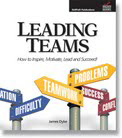This advice is adapted from Jerry R. Wilson’s book, 151 Quick Ideas to Inspire Your Staff. If you want to be an effective leader, you must be able to answer these questions for EACH OF YOUR TEAM MEMBERS.
The first question is the most important and fundamental: WHAT’S MY JOB?
The second question follows the first: HOW WELL AM I DOING IT?
The third question is more profound: What am I part of?
Your job as a team leader is to help your team members to:
- Understand the “big picture” of the organization (how it measures success); and…
- Understand clearly how their team contributes to that success.
Up Close and Personal
In my management training seminars, there is ALWAYS the demand from students that I “understand why our organization is different.” I hear statements like:
- We’re a government agency, not a business.
- This is a business—we have to make a profit.
- We’re a non-profit, not a business!
- This is the military—we’re not like other organizations.
Of course, there is some truth to these statements. What they often overlook is how much ALL ORGANIZATONS have IN COMMON. And THIS is one of the most important and most fundamental:
All organizations require dough to operate.
EVERY ORGANIZATION has a bottom-line! Crucial to any organization’s success is how it acquires and uses money!
- For businesses it has to do with generating profit.
- For non-profits, it’s all about gaining donations.
- For public sector organizations it has to do with tax revenues, bond issues, legislation, and municipal, state, or federal budgets.
Your organization AND YOUR TEAM must function within the restrictions of acquired operating funds. The more your team members understand this all-important reality, the more effectively they can APPLY this knowledge at the next level: their role in helping the organization succeed.
Every team member must have a clear understanding of how their work affects the success of the team and its contribution to the overall success of the organization.
And every team can measure their contribution in actual dollar amounts by determining how they can help increase revenue, savings, or productivity. Because—in the words of my GenX daughter— “It’s all about the dough, Pops!”
Yes indeed, it’s all about the dough:
- How to MAKE IT… how to INCREASE REVENUE
- How to SAVE IT… how to INCREASE SAVINGS
- How to STRETCH IT… how to INCREASE PRODUCTIVITY
So… how is your team making it, saving it, or stretching it?
- How are your team members playing their part in the success of the organization?
- How are you justifying TO YOUR BOSS the value that you are bringing to the organization?
- How is your team supporting more sales or donations?
- How are they saving the organization money?
- How are they increasing their productivity? AND MOST IMPORTANT…How are you measuring the value they add—in dollar amounts?
When your team members understand their connection to the success of the organization, they are also better able to understand how their mistakes, failures, poor quality work, and low productivity COST the organization!
Finally, you need to keep your team informed about the big picture of the organization – how it is performing, competing, growing, and developing. The more information you share with them, the easier it is for them to feel part of the organization; to have a sense of ownership and stewardship; to develop loyalty and support; and to become a true stakeholder in the organization’s success.
Up Close and Personal
I often cite the example of David Payne, a good friend and client. He took charge of a failing factory in his company and applied his brand of positive, effective leadership to completely turn it around and make it the highest-earning profit center in his organization, nation-wide!
One of the things he did to energize his employees, was to conduct regular, information-packed factory-wide meetings. The factory would shut down for the last two hours of the shift; chairs would be set up on the main floor of the factory; and David would lead the meeting with every employee in attendance. (David also PAID the employees for a full day of work—they were able to attend the meetings on the company’s dollar!)
He would use the time to share important information with his factory workers:
- The latest production numbers
- Safety issues and statistics
- The on-time delivery totals
- The amount of money generated by the factory deliverables
- How their numbers compared with other factories in the company
- How the company was performing in their industry and succeeding in key markets
- How the company was growing through acquisition and expansion
Finally, he used the meetings to praise and affirm the great work of his employees. In an earlier post, I shared a sample of his positive and powerful message. He once told his people:
“You are the secret of our company’s success! Our competitors are afraid of you! They fear your skill, your hard work, and your commitment. They fear you because you have the ability to put them out of business, AND THEY KNOW IT!”
I guarantee that every one of David’s employees understood the importance of their job, and why it was imperative to do their job with excellence, and with timeliness!
If you want some ideas about how you can help your team members make a personal connection with your organization and with one another, give us a call – we can help! Our consulting and training resources can help you and your team experience a higher level of morale, better teamwork, and greater productivity!
And if you want to know the rest of the 5 questions, stay tuned to this blogpost series!
Until next time… Yours for better leaders and better organizations,
Dr. Jim Dyke – “The Boss Doctor” ™ helping you to BE a better boss and to HAVE a better boss!





